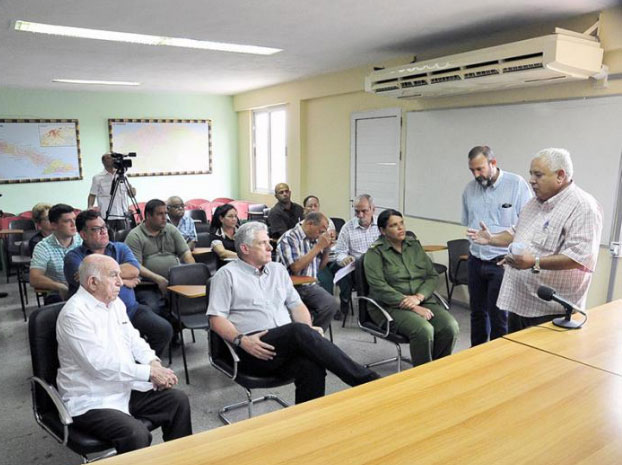
Since noon, May 18, when the sad news of the plane crash in Havana was announced, millions of Cubans have shared the grief of the victims’ families, and been ready to help in any way, from the first moments. The painful initial images, in which the people of Boyeros are seen rushing to offer first aid, attest to the solidarity stemming from this shared sorrow.
As part of this support, Cuban President Miguel Díaz-Canel Bermúdez, together with the Second Secretary of the Communist Party of Cuba, José Ramón Machado Ventura, and Havana authorities, visited victims’ relatives and expressed the permanent support of the Cuban people, government and Party during these difficult moments. You are not alone, Díaz-Canel told them, in the midst of grief impossible to describe in these lines.
The first stop of the tour was the Institute of Forensic Medicine, where its Director, Sergio Rabell, explained that 109 bodies were recovered at the site, a figure to which were added the four people who survived the accident, of which three were in a critical condition, and one died en route to hospital, for a total of 113 people traveling on board the aircraft (at press time, it was reported that one of the three survivors of the disaster, Gretell Landrove Front, a native of Holguín, resident in Havana, died on the afternoon of May 21).
In addition to the Cuban passengers from seven provinces, 67 from Holguín, also on board were two Sahrawis, two Argentines and three Mexicans who were not part of the crew.
So far, 40 bodies had been fully identified, including five children. The specialist insisted that the identification process is extremely complex and could take several days. However, he explained that five groups were working around the clock and had all the necessary conditions to streamline the process.
Meanwhile, Dr. Jorge González, with extensive experience in this type of situation, highlighted the scientific seriousness with which they had been working, and noted that in less than 24 hours all corpses were recovered, despite difficult weather conditions.
A deeply emotional encounter took place a short time later at the Hotel Tulipán, where families of the victims were staying, as Díaz-Canel and Machado Ventura accompanied them and expressed their sympathies.
They offered hugs, words of consolation and condolence, and reiterated the commitment of the government and the Party to support them in everything they need at this difficult time.
The tour continued to the Calixto García University Hospital, where the three survivors of the aviation accident were being treated with great professionalism. Dr. Carlos Alberto Martínez Blanco, director of the institution, reported on the patients’ condition, which he described at that moment as extremely critical.
He explained that the first patient was received around 12:45 on May 18, shortly after the tragedy occurred. From that moment, the hospital’s disaster contingency plan was put into operation to enable immediate attention for the survivors arriving.
He confirmed that all necessary personnel and resources were on hand, that not a moment had been lost in their care, and that solidarity among the workers of the medical institution had prevailed, who from the first moment were ready to undertake any task required.
Díaz-Canel and Machado Ventura spoke with the patients’ relatives, and enquired as to their condition and the frequency with which they received medical updates on their progress.
The last item on the agenda was a visit to the headquarters of the Cuban Aviation Corporation (CACSA), where Havana-based relatives of the victims were being provided with the medical, psychological and legal assistance that this type of situation entails.
At the end of the tour, the Cuban President offered statements to the press in which he stressed, “In the midst of grief and dismay, there has been a great deal of human solidarity, which is expressed in the support for relatives. There has also been efficiency in the handling of all of these cases.”
He also noted, “Work by Forensic Medicine staff was very intense and ongoing until three in the morning on May 20, and thus all the corpses were transferred to the Institute and now the investigative work continues.”
Regarding care for victims’ relatives, he explained that a multidisciplinary team has been created with psychologists, psychiatrists, doctors, as well as Party and government personnel, who systematically provide information to family members.
“In addition, the conditions are created so that families do not have to undertake procedures that are cumbersome, complex, and we can provide those services in a speedier way as the bodies are identified.”
Meanwhile, he added, “In the Calixto García hospital there is a group of doctors, specialists, nurses, who are working with great perseverance and commitment to save the lives of the three patients.
“I believe that there is understanding among the families because they have been informed, they have been treated well, and they have seen the way they are working. There is human warmth, a lot of commitment from people who are making a great effort to overcome the grief and do what is required of them now.”
Díaz-Canel explained that he is in contact with Army General Raúl Castro Ruz, who “has been very attentive to everything, in the midst of his recovery from a planned operation. As soon as he learned of the incident, he began to give instructions; he was informed, following all the information systematically provided, always indicating some detail to take into account, and showing the human sensitivity of our Party First Secretary, leader of the Revolution at this time.” (Taken from en.granma.cu)